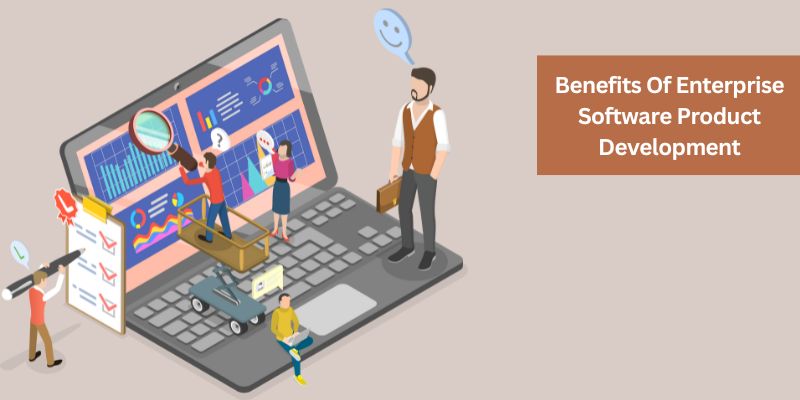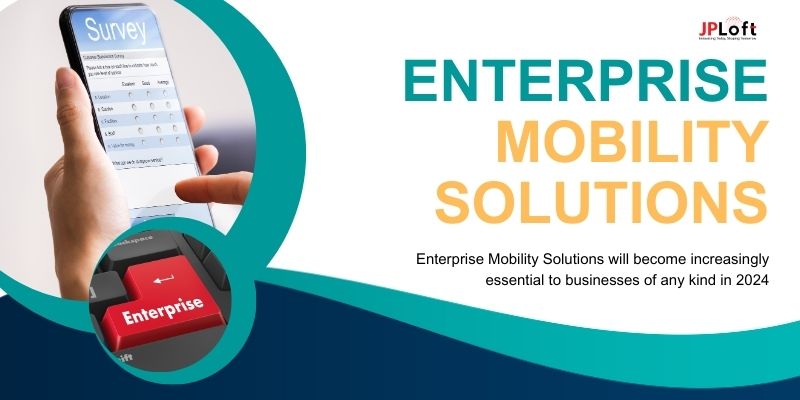Technological change has been advancing daily, which shows an ongoing implementation of the latest technological capabilities. It also raises the need for communication in the age of knowledge—integrating enterprise product development in business management. Business management results from the demands of a knowledge-based economy and labor demands as essential benefits for the contemporary enterprise. Enterprise Product Development Services has been a major component in many companies and organizations and is expected to continue for a long time.
In the same way, the demand for sophisticated software that combines bookkeeping, financial, and project management with procedures and workflows proved to be more important. So, the most prestigious medium—and small-sized companies started adopting enterprise-level software. This is to increase efficiency in various tasks and keep up with the latest trends within modern IT systems.
Phones, computers, smartwatches, tablets, and cars, which provide power to medical and scientific areas, demonstrate the significance of software in our everyday lives. Software is only complete with developers, software, and the development process for the software they use. The software development process has distinct steps that provide the basis for software development's success. There's plenty to learn concerning enterprise product development. It's important to know its purpose, the requirements required to make it successful, and the whole method and methodology that goes with it.
What Is Enterprise Software?
Enterprise software is designed to help large companies address various needs, including data analytics in sales and marketing, customer support, and other needs. Most of these software tools are developed to meet the needs of many customers with high scalability and integration capabilities.
The software is available in big industries, government retailers, hospitals, marketing, sales, finance, and customer service departments. This software needs interdisciplinary processes and methods to handle large amounts of data. Many solutions available on the market offer just this. For example, a program focused on human resources has various HR functions that allow employees to use a single application and produce information in a single go.
The most common kinds of enterprise product development include contact center software, business intelligence, enterprise communications and inventory management, digital payments, marketing tools, and enterprise resource planning. Companies use enterprise software to manage, scale, and enhance their day-to-day activities and procedures and create custom business applications.
Also Read: Difference Between Enterprise and Regular Software Development
Key Features Of Enterprise Product Software
Although the software for enterprise product development systems has a broad definition and varies depending on its goals, each shares a few common elements:
Flexibility
The program must be attractive and affordable so that all users can use the software without difficulty. It must also offer a comfortable management experience that can increase learning and development, evident not just through the process but also in the business's human factor.
Accessibility
Modern business management software distinguishes itself by using cloud-based storage media, which enables access to tools and data anytime, from any location, using any kind of device. Cloud storage isn't the only choice for enterprise software, but having access to your information and digital workspace no matter where you are is one of the most important aspects here.
Scalability
Enterprise software drives firms' development and ensures they constantly develop to meet the demands and changes facing every sector. It adjusts to changing needs that arise within any firm and develops simultaneously. Companies strive to be adaptable in all they do, and the scalability of the business software they use is just one of the Atlanteans that manage their operations.
Integrations
Every business is likely to utilize various solutions regularly. Therefore, it's vital to synchronize these instruments quickly and seamlessly to keep all data sources linked, enabling continuous business processes, uniting business metrics of all kinds, etc. An example of software enterprises use could include Confluence integration with ServiceNow Jira or Microsoft integration.
In recognition of the significance of such integrations, many enterprise software applications include a wide range of integrated integrations built into them, and other third-party companies specialize in such integrations.
Benefits Of Enterprise Software Product Development

Enterprise Product Development Solutions let you create a custom solution that fits your business requirements. Consider the impact this could have for a second. There will be no more hodgepodge options that only meet your requirements. Creating an item tailored to your needs is possible, like a custom-made glove.
Optimize Your Business Processes
Your software will enhance your business by leveraging the information you already know. Creating a system allowing everyone within your organization to swiftly and effectively access updated information is possible. When information circulation increases, so will your staff's performance.
Solves Unique, Niche Needs
Custom software products allow users to boost their operations in ways that off-the-shelf products can't. There are niche requirements that commercial software doesn't address since there are not enough applications. In the case of Microsoft, Salesforce, or any similar software provider, and you're a similar software company, you'll put time and resources into the top functions. An option that just one percent of your clients will utilize is not on the priorities checklist.
Making your own software will allow you to fulfill your business's and other companies' niche needs. A small percentage of an industry giant may make a significant profit for an entrepreneur with a smaller or mid-sized business.
Gives a Competitive Edge
If you develop a system that allows you to be more flexible and productive or more responsive to customers, you'll gain advantages over your competitors. This disadvantage is not easy to eliminate. If you don't white-label your product, and they don't have the option to purchase it, thereby leveling their playing fields, they would have to develop the solution themselves. If they choose to pursue this route, it could take months for them to catch up. This allows for gaining time.
Adapts To Business And Market Change
Changes for tech giants can be erratic, and smaller software companies aren't always able to respond to developments in the marketplace. If you have complete ownership of the product you've created, you can quickly implement changes to accommodate changes and satisfy new demands. When a commercial item might not have updates over a year or more, you can include additional features and upgrade it in a few months.
Must Read: Guide to Enterprise Product Development
Enterprise Software Product Development Process
The process of developing software products is a complex black-and-white process. Much effort is put into creating a step-by-step procedure tailored to your business's requirements. However, it isn't the same. The typical software product creation process includes the following phases.
Plan
The process of planning begins with the vision. The typical vision should focus on an agreed-upon goal or solution. It should consider the intended audience and how it will benefit the people they are targeting. It should also contain fundamental rules and objectives for future development. The rules and objectives may be ambiguous at the start, but they will assist in figuring out what the final goal is, as well as the features and capabilities it will bring to the marketplace.
An In-Depth Analysis Of Needs And Goals
After you've created a strategy and it's been approved, develop a comprehensive analysis of the needs and goals of your plan. Consider the project's scope and then consider its lifespan. Think about your business's goals and how they are accomplished. Think about the following:
-
Design, the needs of your product and code
-
Which frameworks and languages will be utilized?
-
Resources you'll need
Write down all financial and technical elements in your comprehensive analysis. A thorough analysis can assist you in identifying problems earlier and assist in the development of a risk reduction plan.
Designing
Product design is among the crucial stages of the software architecture process. At this point, you'll outline the specifications and project requirements. Participants in the project usually work during this phase to design an initial mockup of the MVP prototype, keeping the desired people in mind. The design should incorporate important functions that complement the ones the product is expected to have.
Design usually requires multiple iterations until you or your group decide on the best one. Be prepared to hear comments from top management and the project's stakeholders. Be aware of this feedback and utilize it to modify and alter the product's design whenever necessary.
The Growth
After you've established a cohesive layout, it's time to begin the development phase. Development encompasses both front and backend development and is crucial in software development. This stage is when your software will get its life. Your software engineering teams will carefully follow the guidelines from previous methods to build your application and implement the features you need.
The final stage can take the longest because it is the most difficult to implement. The Enterprise Product Development Company adheres to the rules you established at the beginning of this process. However, they should also follow best practice guidelines for software and stakeholder expectations.
Testing Is Conducted By Quality Assurance
When you've finished developing your product, it's easy to think the development process is finished. However, it's not. It is essential to test your product with various QA testing instruments to test the continuous integration of functionality, the user's acceptance of the system, and interoperability. The software testing staff thoroughly analyzes and tests the software and its functions. Testing assists in identifying and eliminating any bugs that could be present before the software is made available for public use.
The software testing development team is also responsible for ensuring that the product meets expectations and follows the specifications you set during the planning and creation phase. Remember that quality is the most important factor in your product's success; therefore, be patient during the test stage. After the testing, you'll have an item suitable for deployment.
The Plan Of Implementation Is Executed
Once your product is assessed for quality at the ready, you can start deploying and implementing your software. This is the final step of your software's process. If your software product already exists, implementing it takes your software and features with the production environment, allowing users to use additional capabilities. If your application is brand new, you'll start it for the first time and then deploy it to the system you designed it for.
The implementation plan is much more than simply deploying your ready-to-launch product. Also, you must develop and execute an effective marketing or promotional plan to ensure that your product reaches the intended market. It is possible to do a minor release of your product with just some core features to see how it performs in the marketplace; alternatively, you could conduct an entire product launch and then release your product in all its unique attributes. There are benefits and disadvantages to both types of launches. The choice you make is based on your goals and your goals.
Making Sure Maintenance Is Always Current
When the deployment and implementation of your application are just the beginning of your product's lifecycle, remember to update your product regularly. Whatever the software, it's essential to maintain it. For software, updates to capabilities and services are necessary. Maintenance typically falls to a dedicated resource group that ensures that your product receives the correct updates and bug fixes if problems arise. They also manage software and process upgrades.
Enterprise Software Product Development Methodologies
Software product development is a process, and there are specific methods that software developers must follow.
Waterfall
Also known as the linear sequential model or a traditional model for software development, Waterfall is among the most classic and well-known software development models. It's built on the team working on the project going through each stage of the whole life cycle of software development. In real life, it is possible to see a slight connection between the two steps. For instance, you get customer feedback while creating the new software and return to your previous steps for the necessary changes.
The word "Waterfall" describes a plan-driven process for developing software products that follow an orderly flow, in which the stages are cascaded the next and then down like a waterfall. If, however, you're introducing a new product or desire the flexibility to alter the direction of your product after obtaining customer feedback, Waterfall may not be the best choice for your situation. The software process for developing products is straightforward and clear. However, it comes with one significant drawback: the lack of flexibility. Because of this, companies looking to be agile and adaptable to fast shifts choose to use the latest approach to software development.
Agile And Scrum
An Agile approach is defined as a collection of rules that you must follow to develop a powerful, innovative strategy for developing new software products. Compared to businesses that do not employ Agile methods, 93% of companies that employ it have reported higher customer satisfaction, 76% of them reported higher employee satisfaction, and 93% of them reported improved operating performance.
Scrum is the most well-known implementation of this methodology for software development, and it is employed by eighty percent of Agile teams. Scrum is also a framework that can be used in real life, including instruments and guidelines based on high-level Agile concepts. The combination of Agile and Scrum is a distinct method of software development that deserves a better explanation.
The Agile method is ideal for teams of distributed software developers who expect constant changes throughout the process. That means startups, as well as companies testing innovative products, can gain the most. However, Agile may not work effectively when you're strapped for time and budget or do not know precisely what you want to achieve. Due to its dynamic character, implementing Agile could surpass the budget or create conflicts within the existing software structure.
Incremental And Iterative
They bring together the predictability of Waterfall as well as the scalability of Agile. It is said that the Incremental and Iterative processes are alike, causing focuser portions of functionalities. Their differences lie in the releases that are delivered. When you are in the incremental Enterprise Product Development process, the developer adds one functionality or feature for each period. It is possible to think about building the functionality of a Minimal Viable Product with basic capabilities and then adding more capabilities in the future.
The iterative development process is different because you have to include every feature planned for the first release, or at minimum, the basic version of each. This process will give you flexibility while aiding in sticking to the overall strategy. It can be considered for big projects with clearly defined scopes. However, it is better to choose a different option if you do not possess a long-term, clear technological plan.
Spiral
The final software product design approach we'll discuss combines the versatility of agile, iterative, and Incremental with the testing-driven characteristics of the V-shaped. Every milestone adds to the extent of the project's growth; risk analysis and planning are required to avoid all possible problems in the implementation procedure. This is primarily to reduce the risk. You may think about this method if you have a large budget and are working on a large-scale project with much documentation that must be verified. However, spirals aren't often used because it is time-consuming and expensive. It's an example of critical thinking within the Iterative process.
Read About: Enterprise Mobility Solutions Guide
Enterprise Software Product Development Challenges

Creating a consumable product can be one of the biggest challenges in developing software products. Various significant obstacles could impede your project from the start.
There Needs To Be a Clear-Cut Vision
Uncertainty over the outcome can be commonplace among established and newer businesses. To create a value-for-money solution, the team must understand the goal of building products and the issues they will solve. The long-term goal of the product must be defined within a plan for product development and supported by precise estimates and deliverables.
The Absence Of Documentation
A poorly designed software document could result in costly headaches in the future, from overbudgets and long deadlines to features that don't matter. A lack of documentation results in the absence of a consistent procedure for every step. In addition, inconsistent documentation makes it much more difficult to change software providers.
The Wrong Way To Work
While Agile is touted as the standard of choice in project management, it cannot be used following a set of universal principles. When the standard Agile plans go wrong, and teams are frustrated, they get angry. The art of Agile acceptance lies in knowing the basic principles behind the management method and adjusting an Agile-based framework to suit your project's specific needs.
Inflexibility Of The Product
The most innovative and novel products generally have evolving needs. If the system's design is fixed and rigid, it won't allow you to introduce additional features or alter the current functionality. The same is true for your project management processes. Unless they are flexible and adaptable to changes, they will not allow you to react to changes in project assumptions efficiently and safely.
Unsuccessful Prioritization
Requirements prioritization is essential to planning, budget management, and scheduling software projects. So, your project's backlog must clearly identify tasks according to importance for the development team. Otherwise, you'll waste resources and increase development expenses.
Unsafety In The Psychological Sense
The foundation of the agile method is not Scrum or Kanban; however, it is a positive, conversational process that is a good fit for the development group. If intellectual conflict is not encouraged positively, it will not lead to the development process or encourage collaboration. Every team member is afraid to voice their opinions and offer ideas for solving the problem.
Tech Debt
Tackling technical debt is vital to ensuring long-term sustainability, cutting down on risk while maintaining flexibility in software development. Technical debt can reduce efficiency, scale, and maintenance as it accumulates. To tackle the issue efficiently, you must periodically review the codebase and infrastructure to find areas suffering from technical debt. This is done via code review or automated analysis tools and developer feedback.
The next step is to prioritize the technical debts according to their impact on your system's stability, performance, and maintenance. To efficiently deal with all technical debt, you should use an incremental approach, breaking large refactoring jobs into small, manageable pieces. This can be dealt with in a series of iterative steps without disrupting the ongoing developments.
The Talent Pool Is Depleted
In a time when 1 in 5 businesses need help finding technical talent, the lack of skilled workers could positively impact the progress of your project. This issue is even more critical in national competitive markets and is standard for specialized skills. This means that you could spend an enormous amount of time looking for unicorns.
Finding It Difficult To Strike a Harmony
Failure to achieve the perfect quality-cost balance can result in project failures. This is why teams might struggle to determine the proper amount of money to avoid the possibility of product failures or spending too much money polishing their products. It is crucial to find a compromise between high quality and the quality of a usable product.
Ineffective Communication
Alongside unclear expectations, ineffective communication between the team, its stakeholders, or even departments can cause delays and conflicts. To tackle this issue effectively, you must establish transparent channels of communication. Ensure regular updates and meetings that encourage dialogue and openness, utilize collaboration tools, and communicate clearly, quickly, and punctually. The best way to ensure communication is not a problem is to select a reliable supplier with successfully completed offshore software development projects.
How To Choose The Right Enterprise Software Product
Many firms want to determine which is the most influential business software option. The choice is based on the company's requirements and the process and infrastructure it uses. Here are some essential steps to pick the appropriate enterprise product development for your convenience.
Analyze Business Needs
Defining your business's requirements and assessing processes, departments, and workflows that must be digitized using the application is essential. Look for bottlenecks in place, sketch your possibilities, and contemplate how enterprise software might aid your business.
Check The Structure Of Required Software
The software must be able to adjust to your company's existing physical infrastructure. Otherwise, you must add your newly built infrastructure to the software development project to ensure compatibility with the new system. If additional software for the enterprise is required, it's crucial to discuss how the issue can be addressed with the software provider. Cloud-based and modern technology will significantly help since it is accessible from multiple devices and various areas.
Evaluate The Scalability Of Enterprise Software Solutions
Does the software for managing your business be able to expand in line with business needs? However, it must handle technology demands that can continually optimize processes while maintaining complete control and transparency with a larger operational size. What servers are in use, and what will they require within the next 3-5 years? What's the current user level, and what is your plan for using it? Enterprise firms are known for their plans and strategies over the long run, so it's essential to anticipate the need for the software you are considering to be scalable.
Check On Integration Possibilities
It is crucial to know what functions are built into the selected platform and how they relate to the other platforms already used by the company. Seamless communication among managing tools and procedures is vital to ensure that these processes are agile and allow the creation of a complete plan. Because of the in-depth data analysis and the actionable data software integrations offer, firms can improve their performance and gain more profit.
Final Thoughts
Developing enterprise-level software product procedures requires meticulous coordination, planning, and flexibility to succeed in the competitive market. Conventional methods like Waterfall focus on sequential stages of development, including gathering requirements, designing development, implementation, testing, and deployment taking place sequentially. This approach can provide the structure and predictability needed, but it's also unchangeable in the context of evolving demands or changing market conditions. On the contrary, Agile methodologies, including Scrum, Kanban, and Extreme Programming (XP),encourage incremental and iterative development and strongly focus on delivering working software quickly and frequently.
The easy integration of enterprise product development permits the transfer of information between platforms, making the exchange of information much faster and allowing for the gathering of information with minimal time. Collaboration is brought to a new level, especially for remote or distributed teams. This allows the business to react quickly to business demands, centralize data, and take action by focusing on new strategies and ideas.













Share this blog